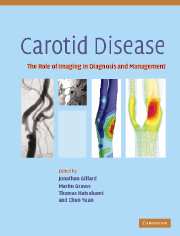Book contents
- Frontmatter
- Contents
- List of contributors
- List of abbreviations
- Introduction
- Background
- Luminal imaging techniques
- Morphological plaque imaging
- Functional plaque imaging
- Plaque modelling
- Monitoring the local and distal effects of carotid interventions
- Monitoring pharmaceutical interventions
- Future directions in carotid plaque imaging
- 34 Molecular imaging of carotid artery disease
- 35 Future technical developments
- Index
- References
34 - Molecular imaging of carotid artery disease
from Future directions in carotid plaque imaging
Published online by Cambridge University Press: 03 December 2009
- Frontmatter
- Contents
- List of contributors
- List of abbreviations
- Introduction
- Background
- Luminal imaging techniques
- Morphological plaque imaging
- Functional plaque imaging
- Plaque modelling
- Monitoring the local and distal effects of carotid interventions
- Monitoring pharmaceutical interventions
- Future directions in carotid plaque imaging
- 34 Molecular imaging of carotid artery disease
- 35 Future technical developments
- Index
- References
Summary
Atherosclerosis and its complications are the scourge of Western civilization, and are becoming increasingly more frequent in the developing world (British Heart Foundation Health Promotion Research Group, 2005). Atherosclerosis affects medium- and large-sized arteries, with the carotid artery being the second most common site after the thoracic aorta (Svindland and Torvik, 1988).
Atherosclerosis is characterized by accumulation of lipid, inflammatory cells and connective tissue within the arterial wall. It is a chronic, progressive disease that has a long asymptomatic phase. The first pathological abnormality is the fatty streak, caused by an aggregation of lipid and macrophages in the subendothelial space. The fatty streak, often present within the aorta from the second decade of life (Ross, 1999), is thought to develop primarily in regions of endothelial dysfunction. Endothelial cells in regions of disrupted flow and low shear stress, often occurring in branch or bifurcation points of the arterial tree (Vander Laan et al., 2004), have decreased production of nitric oxide (Ku et al., 1985). The low shear stress also leads to increased expression of adhesion molecules and uptake of lipoproteins into the subendothelial space by means still unclear (Kinlay et al., 1998). Once oxidized, low density lipoproteins (LDL) are retained in the subendothelial space. Oxidized LDL (oxLDL) contains monocyte chemoattractant factors such as lysophosphatidylcholine and attracts further monocytes by triggering the release of monocyte chemoattractant protein-1 (MCP-1) from endothelial cells and smooth muscle cells (Cushing et al., 1990).
- Type
- Chapter
- Information
- Carotid DiseaseThe Role of Imaging in Diagnosis and Management, pp. 471 - 483Publisher: Cambridge University PressPrint publication year: 2006



